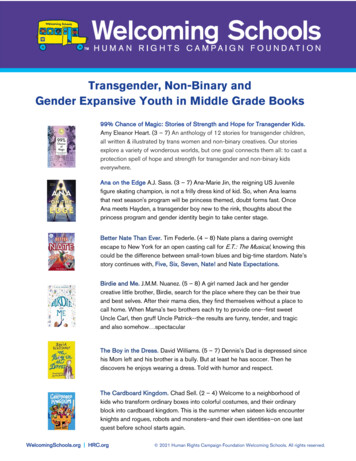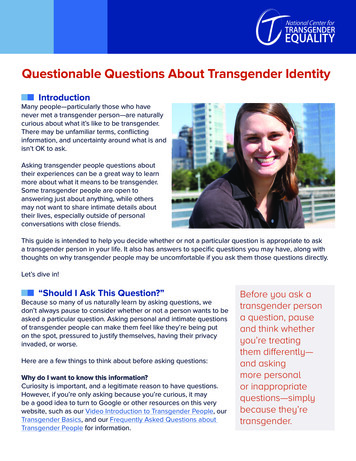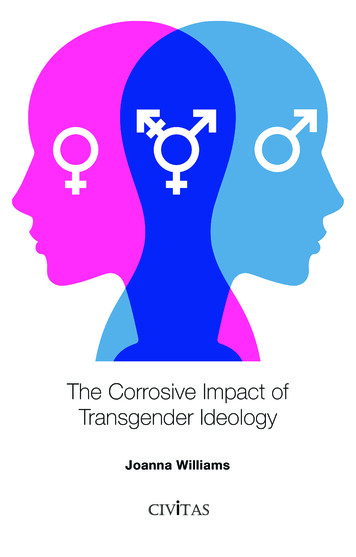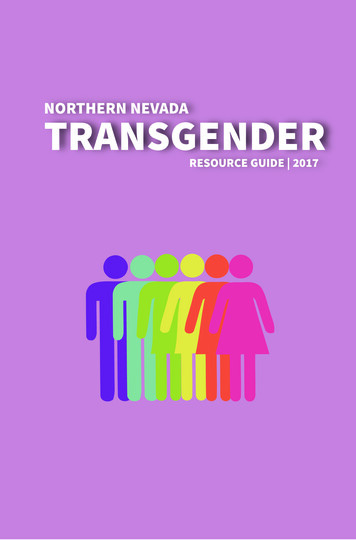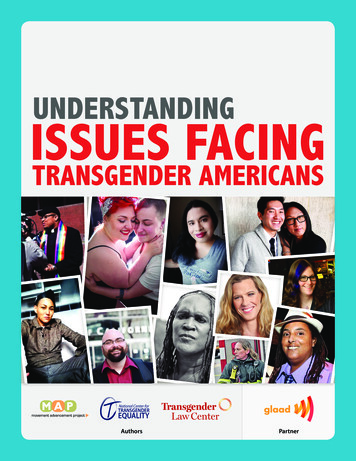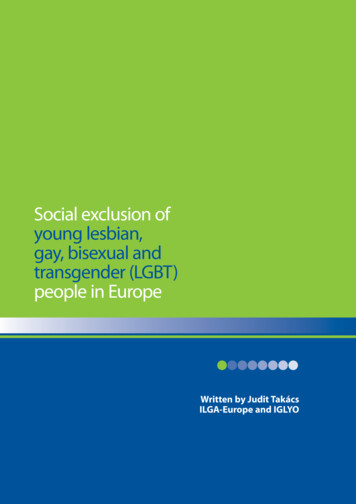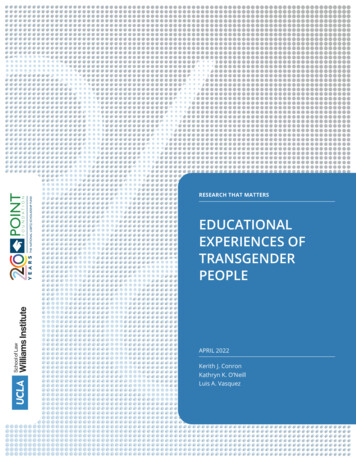
Transcription
RESEARCH THAT MATTERSEDUCATIONALEXPERIENCES OFTRANSGENDERPEOPLEAPRIL 2022Kerith J. ConronKathryn K. O’NeillLuis A. Vasquez
Educational Experiences of Transgender People 1TABLE OF CONTENTSEXECUTIVE SUMMARY. 2INTRODUCTION. 5RESULTS. 7BACKGROUND CHARACTERISTICS. 7BELONGING, SAFETY, AND OUTNESS. 7BELONGING. 7UNFAIR TREATMENT, VIOLENCE, AND HARASSMENT. 9MENTAL HEALTH. 10SCHOOL-LEVEL INDICATORS OF LGBTQ INCLUSION. 10FINANCIAL SUPPORT FOR EDUCATIONAL EXPENSES. 11DISCUSSION . 13AUTHORS. 16ACKNOWLEDGEMENTS. 16SUGGESTED CITATION. 16APPENDIX. 17METHODS. 17TABLES. 19
Educational Experiences of Transgender People 2EXECUTIVE SUMMARYThere are an estimated 218,000 transgender students ages 18 to 40 in the U.S. However, relativelylittle is known about the experiences of transgender people in higher education environments. Thisstudy uses data collected from a nationally representative sample of adults ages 18 to 40 (N 1,072)on the Access to Higher Education Survey to examine the school experiences and higher educationenvironments of transgender people. Cisgender LGBQ adults and non-LGBQ adults are sometimesincluded as comparators. Information is provided about belonging, outness and hiding, schoolbased adversity, LGBTQ- and gender-inclusiveness of higher education environments, and sources offinancial support.A small but representative group of transgender men, women, and non-binary people (n 75) ages18 to 40 answered questions about their experiences in school settings over their lives. One in five(20.9%) transgender people had ever attended vocational, technical, or trade (hereafter vo-tech)programs, 42.7% had been to community college, 59.7% had been to four-year college, and 9.2% hadbeen in graduate school. One in five (20.8%) transgender people chose a school in a different city orstate from where they grew up because they thought it would be more welcoming of someone likethem. Nearly a third (32.4%) of transgender participants were current students at the time of surveycompletion.Transgender adults reported experiences of not fully belonging, needing to hide their sexualorientation or gender identity at school because they are LGBTQ, and experiences of unfair treatment,harassment, or bullying that impacted the quality and quantity of their education. Three times asmany transgender people reported lifetime adverse treatment at school that impacted their academicsuccess or educational attainment as cisgender LGBQ people. Nearly a third of transgender peoplereported unfair treatment by teachers, staff, or school administrators across all of the types ofhigher education institutions that they had attended. And more than a third experienced bullying,harassment, or assault in higher education settings. Findings from this study demonstrate thatexperiences of discrimination against transgender people are not unique to high school and alsooccur in higher education settings.More than half of transgender people reported that their mental health was not good all or most ofthe time that they were in school across all types of higher education institutions. And yet, no morethan a quarter reported the presence of LGBTQ-supportive counseling services or LGBTQ-informedhealth services at their schools. More broadly, LGBTQ- and gender-inclusive resources were reportedby relatively few people.Key FindingsTwo out of five (42.5%) transgender people and one of our four (24.7%) of their LGBQ cisgenderpeers ages 18 to 40 indicated that they felt they did not fully belong at school at some point in theirlives because they are LGBTQ. When asked whether they felt a sense of belonging in specific highereducation settings, only three out of five (59.2%) transgender people reported a sense of belongingacross the higher education institutions that they had attended. Fewer transgender people reportedbelonging in vo-tech programs and community colleges as reported belonging in four-year collegeand graduate schools (44.9% vs. 72.5%, respectively). More than one in seven (14.9%) transgender
Educational Experiences of Transgender People 3people did not feel safe at school across the higher education institutions that they had attended.Just over half (51.7%) of all LGBTQ people reported ever needing to hide their sexual orientation orgender identity at school because they are LGBTQ. Only one in five (21.4%) transgender people was“out” as LGBTQ to most or all of their teachers/faculty and program staff across higher educationinstitutions that they had attended; 44.1% were out to no faculty or staff. Outness to other studentswas somewhat higher than to faculty/staff and differed across school settings. Across settings, almosta third (31.5%) of transgender people reported being out to no other students. More transgenderpeople were out to more students in four-year college and graduate schools than in vo-tech andcommunity colleges.Nearly a third (32.1%) of transgender people reported any unfair treatment by teachers, staff, orschool administrators across the higher education institutions that they had attended. More than athird (38.8%) had experienced any bullying, harassment, or assault in higher education settings. Overa quarter of transgender (26.0%) and almost one in ten (9.4%) LGBQ cisgender people reported thatlifetime school-based unfair treatment, harassment, or bullying due to being LGBTQ was a barrier totheir academic success.Barriers to academic success due to being LGBTQ among transgender and cisgender adults ages18 to 40 (n 572)TransgenderCisgender LGBQ26.0%24.7%23.0%15.2%9.4%7.7%8.1%5.7%Any barrier toacademic successUnfair treatmentat schoolHarassment at schoolBullying at schoolNot surprisingly, more than half (55.3%) of transgender people reported that their mental health wasnot good all or most of the time that they were in school across higher education institutions.Access to Higher Education Survey participants were asked about the extent to which their schools
Educational Experiences of Transgender People 4offered LGBTQ-informed and inclusive services and policies. Integration of LGBTQ issues into existingcourses was the most frequently reported expression of LGBTQ-inclusion—about half (48.5%) oftransgender people reported that LGBTQ issues were part of the curriculum at their school whenthey attended those schools. The presence of one or more gender-neutral bathrooms was reportedby 39.4% of transgender people across educational settings. Across educational settings, 20.1%of transgender people reported that their school had a policy or practice of allowing transgenderstudents the ability to change their gender designation on their program records and documents.LGBTQ-inclusive resources among transgender adults ages 18 to 40 (n 62, k* 112) acrosseducational settings48.5%39.4%31.5%28.5%24.7%Integration ofLGBTQ issues intoexisting coursesOne or LGBTQ studentresource center22.8%LGBTQ-supportive LGBTQ-informedcounseling services health services20.1%Genderdesignationchange processfor administrativerecordsk refers to the number of observations provided by 62 participants. Some participants attended multiple types of*schools over their lives and provided information about their experiences in each school setting while other participantsattended just one.Many transgender people relied upon loans to cover their educational expenses—particularly tofinance four-year college and graduate school. Transgender people were more likely than theircisgender LGBQ and non-LGBQ counterparts to have federal student loans.
Educational Experiences of Transgender People 5INTRODUCTIONThere are an estimated 1.4 million transgender adults in the U.S.,1 including 218,000 students ages18 to 40.2 However, very little is known about the experiences of transgender students—particularlyin higher education. Most prior research has relied upon non-representative samples of youth oradults and has centered on high school and four-year college environments. These studies find thattransgender students experience more violence and harassment in high school and college thantheir heterosexual, cisgender peers.3,4 Harassment of transgender students by school staff andadministrators has also been noted in these settings.5Discrimination, harassment, and bullying negatively impact mental health, school completion,and earnings.6 Not surprisingly, lower levels of education and higher rates of poverty have beendocumented among transgender people versus their heterosexual, cisgender peers.7 And yet, thereis no federal law that expressly protects students from discrimination or harassment based on theirgender identity (or sexual orientation). While some federal prohibitions against sex discriminationhave been interpreted to encompass discrimination motivated by gender identity or sexualorientation in schools, such protections have yet to be formally codified. Transgender and cisgender1Herman, J.L., Flores, A.R., Brown, T.N.T., Wilson, B.D.M., & Conron, K.J. (2017). Age of Individuals Who Identify asTransgender in the United States. The Williams Institute, UCLA, Los Angeles, CA.2The Williams Institute estimates that 218,000 U.S. students ages 18-40 are transgender (range: 153,000 to327,000). We derive these estimates by multiplying percent transgender (1.0%) among students ages 18 to 40 whocompleted the 2019 Behavioral Risk Factor Surveillance System Survey in 32 states that used the optional SexualOrientation and Gender Identity (SOGI) module by the number of 18–40-year-old students enrolled in U.S. schools in2019 (N 21,816,266). Ranges around our estimates were obtained by multiplying the 95% confidence intervals for% transgender (0.7%, 1.5%) to the estimated number of students. All estimates were rounded to the nearest 1,000.The number of students enrolled in public and private schools in the U.S. ages 18 to 40 were obtained from the 2019American Community Survey 1-year estimates of school enrollment (https://data.census.gov/cedsci/table?q B14003%20&d ACS%201-Year%20Estimates%20Detailed%20Tables&tid ACSDT1Y2019.B14003&hidePreview false; TableB14003 “Sex by School Enrollment By Type of School By Age for the Population 3 Years and Over). See COVID-19 and Studentsin Higher Education at uploads/LGBTQ-College-Student-COVIDMay-2021.pdf for further detail.3Coulter, R.W.S. & S.R. Rankin, College Sexual Assault and Campus Climate for Sexual- and Gender-Minority UndergraduateStudents. J Interpers Violence, 2017; Griner, S.B., et al., The Intersection of Gender Identity and Violence: VictimizationExperienced by Transgender College Students. J Interpers Violence, 2017.4Perry, J.R. & S. Frazer. (2020). On All Sides: How Race & Gender Influence Health Risk for Transgender Students of Color.Washington, DC: Advocates for Youth. https:// actionnetwork.org/forms/on-all-sides.5McGuire, J.K., et al., School climate for transgender youth: a mixed method investigation of student experiences and schoolresponses. J Youth Adolesc, 2010. 39(10): p. 1175-88; Toomey, R.B., et al., Gender-nonconforming lesbian, gay, bisexual, andtransgender youth: school victimization and young adult psychosocial adjustment. Dev Psychol, 2010. 46(6): p. 1580-9.6Srabstein, J. & Piazza, T. Public health, safety and educational risks associated with bullying behaviors in Americanadolescents. Int J Adolesc Med Health, 2008. 20(2): p. 223-33.7Badgett, M.V.L., S.K. Choi, & B.D.M. Wilson. (2019). LGBT Poverty in the United States: A Study of Differences betweenSexual Orientation and Gender identity Groups. The Williams Institute, UCLA, Los Angeles, CA; Carpenter, C. S., Eppink,S. T., & Gonzales, G. (2020). Transgender Status, Gender Identity, and Socioeconomic Outcomes in the United States.Ilr Review, 73(3), 573-599; Conron, K.J. & O’Neill, K. (2021). Food Insufficiency Among Transgender Adults During theCOVID-19 Pandemic. The Williams Institute, UCLA, Los Angeles, CA.
Educational Experiences of Transgender People 6LGBQ students also continue to face a patchwork of protections under state law. Half of states donot have laws or policies that prohibit discrimination based on gender identity or sexual orientationin schools.8 Over half lack legal requirements that schools enumerate gender identity and sexualorientation within their anti-bullying policies, and those that do limit such protections to primary andsecondary students.9This study uses a nationally representative sample of adults ages 18 to 40 who completed the Accessto Higher Education Survey to examine the school experiences of transgender people in a variety ofhigher education settings. Information about belonging, hiding, school-based adversity, and sourcesof financial support is provided. This study also adds new information about the extent to which thehigher education environments of transgender students are LGBTQ- and gender-inclusive.8Movement Advancement Project. Safe Schools Laws. https://www.lgbtmap.org/equality-maps/safe school laws.Accessed March 2022.9Movement Advancement Project. Safe Schools Laws. https://www.lgbtmap.org/equality-maps/safe school laws.Accessed March 2022.
Educational Experiences of Transgender People 7RESULTSBACKGROUND CHARACTERISTICSTransgender participants were demographically similar to cisgender LGBQ and non-LGBQ participantson many characteristics, including race-ethnicity and lifetime educational attainment (Table 1), anddiffered on others. Transgender participants were younger, on average, than cisgender LGBQ andnon-LGBQ participants—as has been observed in other samples.10 Almost half (47.2%) of transgenderparticipants, 36.3% of cisgender LGBQ, and 28.8% of cisgender non-LGBQ participants were ages18 to 24. More transgender participants were current students (32.4%) than were cisgender LGBQ(28.0%) and non-LGBQ participants (18.6%), which is likely due, at least in part, to the younger agecomposition of the transgender group.One in five (20.9%) transgender participants had ever attended vo-tech programs, 42.7% hadbeen to community college, 59.7% had been to four-year college, and 9.2% had been in graduateschool. Lifetime patterns of school attendance were similar among cisgender LGBQ and non-LGBQparticipants. One in five (20.8%) of transgender people reported that they picked a school of highereducation in a different city or state from where they grew up because they thought it would be morewelcoming of someone like them (Table 3).More than three-quarters (78.4%) of transgender participants reported that their sex assigned atbirth was female (Table 1). Many transgender participants (61.0%) selected just one gender identity;however, 39.0% chose two or more identities. About a third (29.7%) of transgender adults selectedmale, 17.2% selected female, about a third (30.9%) endorsed transgender as their gender identity,over half (54.8%) selected non-binary, and 10.8% chose a different identity. Transgender participantswere diverse on sexual orientation identity and half identified their sexual orientation as lesbian, gay,or bisexual (LGB). More specifically, 40.3% identified as bisexual, 39.7% as “something else,” and 9.7%identified as gay or lesbian, and 10.4% as straight.BELONGING, SAFETY, AND OUTNESSBelongingTwo out of five (42.5%) transgender participants and one out of four (24.7%) of their LGBQ cisgenderpeers ages 18 to 40 reported that they felt they did not fully belong at school at some point in theirlives because they are LGBTQ (Table 2). Cisgender non-LGBQ participants were not asked questionsabout lifetime school experiences related to being LGBTQ.10James, S. E., Herman, J. L., Rankin, S., Keisling, M., Mottet, L. A., & Anafi, M. (2016). The Report of the 2015 U.S.Transgender Survey. National Center for Transgender Equality, Washington, DC; Meyer, I.H., Wilson, B.D.M., & O’Neill,K. (2021). LGBTQ People in the US: Select Findings from the Generations and TransPop Studies. Los Angeles: The WilliamsInstitute.
Educational Experiences of Transgender People 8Figure 1. Ever felt didn’t fully belong at a school due to being LGBTQ among transgender andcisgender adults ages 18 to 40 (n 572)42.5%24.7%TransgenderCisgender LGBQWhen asked whether they felt a sense of belonging in specific higher education settings, 59.2% oftransgender participants reported a sense of belonging across higher education institutions thatthey had attended (Table 3). Fewer transgender people reported belonging in vo-tech programs andcommunity colleges as reported belonging in four-year college and graduate schools (44.9% vs. 72.5%).Figure 2. Sense of belonging among transgender adults ages 18 to 40 (n 62, k 112) by educationalsetting72.5%59.2%44.9%Vo-tech andcommunity collegeFour-year college andgraduate schoolAll educationalsettingsSafetyMore than one in seven (14.9%) transgender participants did not feel safe at school across the highereducation institutions that they had attended (Table 3).
Educational Experiences of Transgender People 9OutnessJust over half (51.7%) of all LGBTQ participants reported ever needing to hide their sexual orientationor gender identity at school because they are LGBTQ, including 65.6% of transgender and 49.7% ofcisgender LGBQ people11 (Table 2).Only one in five (21.4%) transgender participants was “out” as LGBTQ to most or all of their teachers/faculty and program staff across higher education institutions that they had attended; 44.1% were outto no faculty or staff (Table 3). Outness to other students was somewhat higher than to faculty/staffand differed across school settings. Across settings, almost a third (31.5%) of transgender participantsreported being out as LGBTQ to most or all students at their school and the same proportion (31.5%)was out to no peers. More transgender participants were out to more students in four-year collegeand graduate schools than in vo-tech and community colleges.UNFAIR TREATMENT, VIOLENCE, AND HARASSMENTNearly a third (32.1%) of transgender participants reported any unfair treatment by teachers, staff,school administrators across the higher education institutions that they had attended (Table 3). Morethan a third (38.8%) had experienced any bullying, harassment, or assault in higher education settings.Over a quarter of transgender (26.0%) and almost one in ten (9.4%) LGBQ cisgender participantsreported that lifetime school-based unfair treatment, harassment, or bullying due to being LGBTQwas a barrier to their academic success (Table 2).Figure 3. Lifetime barriers to academic success due to being LGBTQ among transgender and LGBQcisgender adults ages 18 to 40 (n 572)TransgenderCisgender LGBQ26.0%24.7%23.0%15.2%9.4%7.7%8.1%5.7%Any barrier toacademic success11Unfair treatmentat schoolHarassment at schoolBullying at schoolThe difference between transgender and cisgender LGBQ participants in the proportions that reported ever needingto hide their sexual orientation or gender identity at school because they are LGBTQ was not statistically significantlydifferent at p 0.05.
Educational Experiences of Transgender People 10Nearly a quarter (23.2%) of transgender and 7.6% of LGBQ cisgender participants reported thatlifetime school-based unfair treatment, harassment, or bullying due to being LGBTQ was a barrier togetting the amount of education, training, or degrees that they wanted.Figure 4. Barriers to educational attainment due to being LGBTQ among transgender andcisgender LGBQ adults ages 18 to 40 (n 572)Transgender23.2%Cisgender LGBQ21.5%18.2%14.2%7.6%5.1%Any barrier to gettingdesired amount ofeducation, training ordegree because you areLGBTQUnfair treatmentat school5.7%Harassment at school6.6%Bullying at schoolMENTAL HEALTHMore than half (55.3%) of transgender participants reported that their mental health was not good allor most of the time that they were in school across higher education institutions (Table 3).SCHOOL-LEVEL INDICATORS OF LGBTQ INCLUSIONAccess to Higher Education Survey participants were asked about the extent to which their schoolsoffered LGBTQ-informed and inclusive services, resources, policies, and practices (Table 4). Integrationof LGBTQ issues into existing courses was the most frequently reported expression of LGBTQinclusion—across community college, four-year college, and graduate programs about half (48.5%) oftransgender participants reported that LGBTQ issues were part of the curriculum at their school whenthey attended those schools. LGBTQ student resource centers were reported more often at four-yearcollege and graduate programs (42.0%) than at vo-tech and community colleges (13.9%).The presence of one or more gender-neutral bathrooms was reported by 39.4% of transgenderparticipants across educational settings. Gender-inclusive housing was reported by 31.5% oftransgender participants who attended four-year college or graduate programs. Gender-inclusivehousing was defined as housing not segregated into men’s and women’s spaces—including double
Educational Experiences of Transgender People 11and multiple occupancy bedrooms—and welcoming to students who identify outside of the genderbinary “man/woman.”Across educational settings, 20.1% of transgender participants reported that their school had a policyor practice of allowing transgender students to change their gender designation on their programrecords and documents, while many (57.6%) did not know if their school had such a practice. Thepresence of LGBTQ-competent health and counseling services were reported by only 22.8% and24.7%, respectively, of transgender participants across education settings. Roughly half did not knowif their programs, college, or universities had such resources when they attended them.Figure 5. LGBTQ-inclusive resources among transgender adults ages 18 to 40 (n 62, k 112) acrosseducational settings48.5%39.4%31.5%28.5%24.7%Integration ofLGBTQ issues intoexisting coursesOne or LGBTQ studentresource center22.8%LGBTQ-supportive LGBTQ-informedcounseling services health services20.1%Genderdesignationchange processfor administrativerecordsFINANCIAL SUPPORT FOR EDUCATIONAL EXPENSESTransgender participants reported a range of funding sources for educational expenses (tuition andfees, living expenses), including family resources, savings or work, grants, scholarship, and loans(Table 5). Savings from work, work-study, and other personal income were a source of educationalfunding for 67.1% of participants across educational settings while family resources were reportedby half (51.2%) of participants. Grants and scholarships were reported more often as funding sourcesfor four-year college and graduate school (82.3%) than vo-tech programs and community collegeexpenses (57.4%). Loans were also reported more often as funding sources for four-year college andgraduate school (71.6%) than vo-tech programs and community college expenses (33.7%).
Educational Experiences of Transgender People 12Federal Loans and Other Student DebtTransgender participants were more likely to have federal student loans than their cisgenderLGBQ and non-LGBQ counterparts, (51.0%, 33.1%, and 23.2%, respectively).12 In total, 15.1% of alltransgender people owed less than 10,000, one quarter (25.1%) owed between 10,000 to under 50,000, and 10.9% owed 50,000 or more in federal student loans. Nearly one in five (17.9%)participants, across gender and sexual orientation groups, held other student debt in the form ofprivate student loans from a bank or other lending institution or from credit cards or other loans.Figure 6. Any federal student loans among adults ages 18 to 40 by gender and sexual orientation(N 1,072)51.0%33.1%23.2%Transgender12Cisgender LGBQCisgendernon-LGBQDifferences in the odds of having federal student loans between gender and sexual orientation groups persist evenafter taking differences in the age composition of each group into consideration (transgender vs. cisgender LGBQ ageadjusted Odds Ratio 2.1; 95% Confidence Interval, 1.1, 4.1; transgender vs. cisgender non-LGBQ OR 3.4, 95% CI 1.7,6.5).
Educational Experiences of Transgender People 13DISCUSSIONThis study reported on the school experiences of a small, but representative group of transgendermen, women, and non-binary people ages 18 to 40. Findings from this study show that transgenderpeople experience bullying, harassment, assault, and unfair treatment in higher education settings.About one quarter of transgender people indicate that these types of experiences were barriers totheir academic success and educational attainment over the course of their lives.No federal law expressly protects students from discrimination or harassment based on their genderidentity or sexual orientation. However, an increasing number of courts and federal agencies haveexpanded protections for LGBTQ students under Title IX of the Education Amendments of 1972 (TitleIX).13 Title IX prohibits any education program or activity receiving federal financial assistance fromdiscriminating against individuals on the basis of their sex, including that individuals not be excludedfrom participation in or denied the benefits of covered programs or activities because of sex.14 Thereach of Title IX is broad, and has long been understood to cover all of the operations of “traditionaleducational institutions” like elementary and secondary schools, colleges and universities, andvocational and trade programs.15 Title IX has been used alongside other civil rights statutes in supportof a wide range of policies and initiatives related, but not limited to, recruitment, admissions, andcounseling; student financial aid; athletics; discipline; and enforcement against acts of harassment.16While Title IX does not expressly enumerate gender identity or sexual orientation like it does sex,the Departments of Justice and Education and various federal courts have recently aligned in theview that the statute nevertheless encompasses both bases,17 consistent with the Supreme Court’sreasoning in Bostock v. Clayton County.18 In addition, the Department of Education has expressedits intent to amend its regulations implementing Title IX to be inclusive of gender identity or sexualorientation by April 2022,19 consistent with recent executive orders.20 These changes are expected to13Department of Education. Resources for LGBTQI Students. ml.Accessed March 2022.1420 U.S.C. § 1681(a).1534 C.F.R. § 106.2(h)(2); Department of Justice. Title IX. https://www.justice.gov/crt/title-ix. Accessed March 2022.16Department of Education. Title IX and Sex Discrimination. x dis.html. Accessed March 2022.17Memorandum from Pamela S. Karlan, Principal Deputy Assistant Att’y Gen., Civil Rights Div., U.S. Dep’t of Justice, toFederal Agency Civil Rights Directors and General Counsels (Mar. 26, 2021); Enforcement of Title IX of the EducationAmendments of 1972 with Respect to Discrimination Based on Sexual Orientation and Gender Identity in Light ofBostock v. Clayton County, 86 Fed. Reg. 32,637 (June 22, 2021); see, e.g., Gr
education settings, only three out of five (59.2%) transgender people reported a sense of belonging across the higher education institutions that they had attended. Fewer transgender people reported belonging in vo-tech programs and community colleges as reported belonging in four-year college and graduate schools (44.9% vs. 72.5%, respectively).
